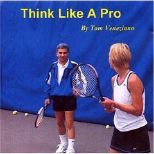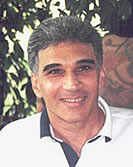Contrary to popular belief, the direction in which you swing your racket does not determine the direction of the ball. So what does determine the direction of the ball? The racket face!
The idea that if you swing up the ball goes up and if you swing down the ball goes down is, in most players' minds, a rooted truism. This seems logical, but in practice this is not true and is the source of much miscalculation when solving stroke problems.
To add to the confusion, many coaches teach players to swing toward their target to get the ball to go where they want. If players want the ball to go crosscourt, they swing the racket in that direction. If players want the ball to go down the line, they swing the racket in that direction. This instruction only instills a false "racket swing truism" in players' minds. Whether swinging up or down, the true secret to ball direction is control of the racket face.
Let's examine this concept a little closer, beginning with the slice groundstroke. A backhand or forehand slice groundstroke is hit with a downward swing of the racket. If that is true (and it is) how is it possible that the ball can be sliced and then go up over the net? The racket is swinging downward so the ball should go down, right? No. While the racket is swinging downward the face of the racket is open, pointed upward toward the sky. The downward swing merely puts spin on the ball. The open racket face determines the ball's direction. Racket face control is king in tennis!
How about topspin? The premier topspin player of the day would have to be Rafael Nadal, with his buggy whip forehand swing over the wrong shoulder. Nadal's swing is dramatically upward. If the swing determines the ball direction, Nadal must be trying to land the ball on the moon because that is the direction his racket is moving! Yet as Nadal swings upward, the racket face is pointed forward, thus sparing any additional craters on the moon.
How about when a pro returns a blasting serve? All he or she does is block the ball with no swing and the ball goes in the direction he or she is aiming. There was no swing, just a bunt at the ball and off it goes to the desired target. The swing did not determine the direction of the ball because there wasn't one!
From these three examples, it should be clear that the racket face determines the direction of the ball, not the swing. How can you use this information in application? Simple. Stop thinking that the swing will make the ball go where you are aiming. To master ball placement, begin thinking that the racket face is king. Even if you do not have the so-called perfect stroke (most do not, including the pros), if you can practice adjusting the racket face you will eventually find the shot.
As always, repetition is the secret to learning and developing a feel for the racket face. In your practices, experiment with opening and closing the racket face to begin developing a feel. You can also practice hitting the ball down the line or crosscourt by adjusting the racket face and pointing it in the direction of the intended target. When attempting to adjust the racket face do not change your grip. Keep the same grip, and adjust your wrist position instead. Moving your wrist automatically changes the face of the racket. When your racket face changes, so will the direction of your shot.
Even if your strokes are wrong, even if you swing to the moon, even if you don't swing at all, if you have mastered racket face control, then guess what? You will be king!










 You will join 13,000 other subscribers in receiving news of updates to the Tennis Server along with monthly tennis tips from tennis pro Tom Veneziano.
You will join 13,000 other subscribers in receiving news of updates to the Tennis Server along with monthly tennis tips from tennis pro Tom Veneziano. 